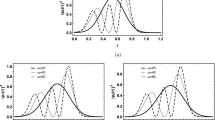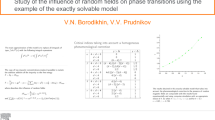Abstract
When a system that undergoes a continuous phase transition is swept through its critical point the initial symmetry is broken and domains are formed. Because of critical slowing down it is not possible to sweep adiabatically; the number of domains therefore depends on the rate of increase of the critical parameter. We give a summary of recent theoretical results for the number of defects produced as a function of how rapidly the transition point is passed. They are obtained from a simplified model, using a stochastic partial differential equation that is also solved numerically.
Similar content being viewed by others
REFERENCES
Adler, R. J. (1981). The Geometry of Random Fields, Wiley, Chichester.
Bäuerle, C. et al. (1996). Nature 382, 332–334.
Bettencourt, L. M. A., Habib, S., and Lythe, G. (1999). Physical Review D 60, 105039.
Currie, J. F., Krumhansl, J. A., Bishop, A. R., and Trullinger, S. E. (1980). Physical Review B 22, 477.
Da Prato, G. and Zabczyk, J. (1992). Stochastic Equations in Infinite Dimensions, Cambridge University Press, Cambridge.
Dodd, M. E. et al. (1998). Physical Review Letters 81, 3703.
Doering, C. R. (1987). Communications in Mathematical Physics 109, 537–561.
Ducci, S. et al. (1999). Physical Review Letters 83, 5210.
Funaki, T. (1983). Nagoya Mathematical Journal 89, 129–193.
Gill, A. J. and Kibble, T.W. B. (1996). Journal of Physics A: Mathematical and General 29, 4289–4305.
Gyöngy, I. and Pardoux, E. (1993). Probab. Theory Relat. Fields 94, 413–426.
Habib, S. and Lythe, G. (2000). Physical Review Letters 84, 1070.
Hendry, P. C. et al. (1994). Nature 315, 315–317.
Ito, K. (1964). J. Math. Kyoto Univ. 32, 207.
Jansons, K. and Lythe, G. (1998). Journal of Statistical Physics 90, 227.
Karra, G. and Rivers, R. J. (1998). Physical Review Letters 81, 3707.
Kavoussanaki, E., Monaco, R., and Rivers, R. J. (2000). Physical Review Letters 85, 3452.
Knight, F. B. (1981). Essentials of Brownian motion and diffusion, American Mathematical Society, Providence.
Krumhansl, J. A. and Schrieffer, J. R. (1975). Physical Review B 11, 3535.
Laguna, P. and Zurek, W. H. (1997). Physical Review Letters 78, 2519–2522.
Lythe, G. D. (1994). Stochastic Partial Differential Equations, A. Etheridge, ed., Cambridge University Press, Cambridge, pp. 181–188.
Lythe, G. D. (1996). Physica Review E 53, R4271–R4274.
Lythe, G. D. (1997). Proceedings of the VIII Spanish Meeting on Statistical Physics FISES'97, J. A. Cuesta and A. Sanchez, eds., Editorial del Ciemat, Madrid, pp. 55–62.
Lythe, G. and Habib, S. (in press). Journal of Computational Physics.
Lythe, G. D. and Proctor, M. R. E. (1993). Physica Review E 47, 3122–3127.
Moro, E. and Lythe, G. (1999). Physica Review E 59, R1303–1306.
Rivers, R. J. (2000). Physical Review Letters 84, 1248.
Ruutu, V. M. H. et al. (1996). Nature 382, 334–335.
Scalapino, D. J., Sears, M., and Ferrell, R. A. (1972). Physical Review B 6, 3409.
Stocks, N. G., Mannella, R., and McClintock, P. V. E. (1989). Physical Review A 40, 5361.
Swift, J. W., Hohenberg, P. C., and Guenter Ahlers. (1991). Physical Review A 43, 6572.
Torrent, M. C. and San Miguel, M. (1988). Physical Review A 38, 245.
Trullinger, S. E. and Sasaki, K. (1987). Physica D 28, 181.
van den Broeck, C. and Mandel, P. (1987). Physics Letters A 122, 36–38.
Walsh, J. B. (1986). An introduction to stochastic partial differential equations. In Ecole d'étéde probabilités de St-Flour XIV, P. L. Hennequin, ed. (Springer, Berlin, pp. 266–439).
Zurek, W. H. (1985). Nature 317, 505–508.
Zurek, W. H. (1993). Acta Physica Polonica B 24, 1301–1311.
Zurek, W. H. (1996). Physics Reports 276, 177–221.
Author information
Authors and Affiliations
Rights and permissions
About this article
Cite this article
Lythe, G. Defect Formation in a Dynamic Transition. International Journal of Theoretical Physics 40, 2309–2316 (2001). https://doi.org/10.1023/A:1012994406249
Issue Date:
DOI: https://doi.org/10.1023/A:1012994406249




